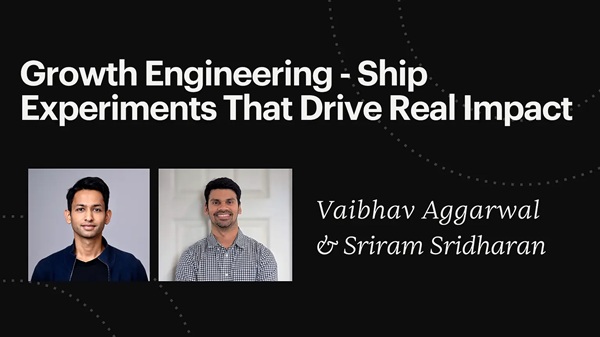[GroupBuy] Growth Engineering – Ship Experiments That Drive Real Impact
$1,997.00 Original price was: $1,997.00.$49.00Current price is: $49.00.
- Delivery: You Will Receive A Receipt With Download Link Through Email.
- If you need more proof ofcourse, feel free to chat with me!

Description
Table of Contents
ToggleGrowth Engineering is a dynamic field that utilizes product-driven experimentation to accelerate user and business growth. It combines technical expertise with a deep understanding of user behavior to optimize the entire customer journey. This article explores the principles and practices of Growth Engineering, outlining how engineers can Ship Experiments That Drive Real Impact.
Growth Engineering
Growth Engineering represents a paradigm shift in how companies approach user acquisition and retention. Moving beyond traditional marketing tactics, it focuses on building growth directly into the product itself through data-driven experimentation and iterative improvements.
The Evolution of Growth Engineering
The rise of Growth Engineering is a fascinating story, one that reflects the changing landscape of the tech industry. A decade ago, the term was virtually unheard of. Companies relied heavily on marketing budgets and paid advertising to attract and retain users. Growth was seen as a function of external factors, something separate from the core product development process.
Then came the pioneers – companies like Facebook and Pinterest. These organizations recognized the immense potential of leveraging the product itself as a Growth engine. They started experimenting with product features, user interfaces, and onboarding flows, meticulously tracking the impact of each change on key metrics. This data-driven approach allowed them to identify and implement strategies that significantly accelerated Growth organically. They began to build algorithmic experiments into their product. This was a monumental shift – a move towards product-led Growth.
This marked a turning point, forever altering the landscape of user acquisition. It demonstrated that Growth wasn’t just about spending money on ads; it was about understanding user behavior, identifying friction points, and iteratively optimizing the product to create a more engaging and valuable experience. This involved understanding the product to accelerate Growth directly from the product itself. Today, Growth Engineering is an indispensable part of any successful tech company. It’s no longer a niche discipline but a core function, integral to driving sustainable and scalable Growth. It’s considered a powerful lever for product Growth.
Key Challenges and Distinctions
Despite its growing importance, Growth Engineering still faces a significant perception gap. Many engineers, particularly those with a traditional product engineering background, struggle to grasp the fundamental differences between the two disciplines. Traditional product engineering focuses on building and maintaining core product features, prioritizing functionality, stability, and scalability. Growth Engineering, on the other hand, is laser-focused on driving measurable Growth in key metrics, such as user acquisition, activation, retention, and revenue. This entails a different mindset and a different set of skills.
One of the biggest challenges is designing and executing effective experiments. It’s not enough to simply A/B test random features; Growth Engineers must identify high-impact opportunities, formulate clear hypotheses, and meticulously track the results. They must also be adept at data analysis, extracting meaningful insights from vast datasets to inform future experiments. The role demands thinking beyond execution and operate like a full-stack Growth owner.
The data-driven approach is another critical distinction. Traditional product engineers may focus on technical metrics, such as code quality and performance, while Growth Engineers are primarily concerned with user behavior and business outcomes. They must be proficient in identifying the right metrics to track, building robust instrumentation, and translating data into actionable insights.
The most significant difference lies in the mindset. Growth Engineers are relentlessly focused on Growth, constantly seeking new opportunities to optimize the user experience and drive tangible results. They embrace a scientific approach, treating the product as a living laboratory and continuously iterating based on data and feedback. This emphasis on experimentation and data distinguishes it from traditional product engineering. Growth Engineering differs from traditional product engineering in its goals, mindset, and workflows, emphasizing a Growth-first perspective that drives outcomes, not just features.
Becoming a Growth Engineer: Skills and Mindset
So, what does it take to become a successful Growth Engineer? It’s more than just technical proficiency; it requires a unique blend of skills, mindset, and experience. A strong foundation in software engineering is essential, but it’s only the starting point. Growth Engineers must also possess a deep understanding of user behavior, marketing principles, and data analytics.
One of the most crucial skills is the ability to design and execute experiments effectively. This involves formulating clear hypotheses, selecting appropriate metrics, implementing robust testing methodologies, and analyzing the results with rigor. It also requires a willingness to embrace failure, as not every experiment will yield positive results.
Moreover, Growth Engineers must be comfortable working in a fast-paced, iterative environment. They need to be able to quickly prototype new features, A/B test different variations, and iterate based on user feedback. This requires a high degree of agility, adaptability, and a willingness to learn continuously.
In addition to technical skills, Growth Engineers must also possess strong communication and collaboration skills. They need to be able to effectively communicate their ideas to stakeholders across different departments, including product managers, marketers, and designers. This requires the ability to translate technical concepts into business terms and to build consensus around Growth initiatives.
Ultimately, the key to success in Growth Engineering is a Growth-oriented mindset. Growth Engineers are relentlessly focused on finding new ways to improve the user experience and drive tangible results. They are data-driven, analytical, and always looking for opportunities to optimize the product. They must learn how to build the right instrumentation to track meaningful metrics. This involves understanding what to track, how to track it, and how to translate data into actionable insights that lead to better decisions and faster iteration.
Ship Experiments That Drive Real Impact
To Ship Experiments That Drive Real Impact, it’s crucial to move beyond theoretical knowledge and delve into practical application. This involves understanding the end-to-end process of experiment design, execution, and analysis, as well as the tools and techniques used by leading Growth teams at top companies.
Mastering the Fundamentals of Experimentation
Experimentation is the bedrock of Growth Engineering. Without a solid understanding of experimentation principles, even the most talented engineer will struggle to Ship Experiments That Drive Real Impact. This starts with mastering the art of formulating clear and testable hypotheses.
A hypothesis is more than just a guess; it’s an educated prediction about the impact of a specific change on a particular metric. It should be specific, measurable, achievable, relevant, and time-bound (SMART). For example, instead of saying “We should improve the onboarding flow,” a good hypothesis might be: “Improving the clarity of the call-to-action on the sign-up page will increase user registration by 10% within one week.”
Once the hypothesis is formulated, the next step is to design the experiment. This involves selecting the appropriate testing methodology, such as A/B testing, multi-variate testing, or split testing. It also involves determining the sample size, control group, and treatment group. Building the confidence to go beyond execution and ideate impactful Growth opportunities from scratch. This involves learning how to connect product sense, user behavior, and data to identify high-leverage Growth opportunities—then turn those into experiments.
The implementation phase is equally critical. It’s essential to ensure that the experiment is set up correctly, with accurate tracking and instrumentation. This involves building custom analytics dashboards, integrating with third-party tools, and monitoring the results closely. Participants will master the fundamentals of Growth Engineering.
Finally, the analysis phase is where the rubber meets the road. This involves analyzing the data to determine whether the hypothesis was supported or refuted. It also involves identifying any unexpected insights or trends that may emerge from the data. This analysis should be rigorous, objective, and free from bias. Learning how to build experiments end to end—from ideation to shipping to analysis—and use those learnings to move key metrics meaningfully.
Here’s a table that highlights key differences in experimentation approaches:
| Feature | A/B Testing | Multivariate Testing |
|---|---|---|
| Objective | Compare two versions of a single variable to determine which performs better. | Test multiple variations of multiple variables simultaneously to determine which combination performs best. |
| Complexity | Simpler to implement and analyze. | More complex to implement and analyze, requires more traffic to achieve statistical significance. |
| Variables Tested | Tests a single change at a time. | Tests multiple changes simultaneously, allowing for identification of the optimal combination. |
| Traffic Required | Requires less traffic to achieve statistical significance. | Requires significantly more traffic as the number of variables and combinations increases. |
| Use Cases | Ideal for testing simple changes like button colors, headlines, or single page layouts. | Suitable for testing complex designs with multiple elements that might interact with each other. |
| Example | Testing two different call-to-action buttons on a landing page. | Testing different combinations of headlines, images, and button placements on a webpage. |
The Importance of Instrumentation and Data-Driven Decision Making
Effective experimentation hinges on robust instrumentation. Without accurate and comprehensive data, it’s impossible to objectively measure the impact of experiments and make informed decisions. Growth Engineers must be proficient in building instrumentation that tracks key metrics, such as user acquisition, activation, retention, and revenue. Mastering effective Experimentation is a central focus is to run experiments effectively using real tools and proven frameworks.
This involves embedding tracking code throughout the product, integrating with analytics platforms, and building custom dashboards to visualize the data. It also requires careful attention to data privacy and security, ensuring that user data is collected and stored in accordance with applicable regulations. Data-driven decision-making is the cornerstone of Growth Engineering. Decisions should be based on evidence, not intuition or gut feelings. This requires a deep understanding of statistical analysis, data visualization, and experimental design.
Growth Engineers must be able to extract meaningful insights from data, identify trends, and make predictions about future user behavior. They must also be able to communicate their findings effectively to stakeholders across different departments. A data-first mindset is crucial. It means approaching every decision with a skeptical eye, demanding evidence, and continuously testing assumptions. It also means embracing failure as a learning opportunity, using data to understand why an experiment failed and to inform future iterations.
Real-World Tools and Techniques
The world of Growth Engineering is constantly evolving, with new tools and techniques emerging all the time. It’s essential for Growth Engineers to stay abreast of the latest developments and to be proficient in using the tools and techniques that are most relevant to their work. The course emphasizes hands-on learning with real-world tools and techniques used by top Growth teams at companies like Postman, Opendoor & Coinbase. It promises no fluff, just proven methods from Growth teams at scale.
Some of the most popular tools include A/B testing platforms like Optimizely and VWO, analytics platforms like Google Analytics and Mixpanel, and data visualization tools like Tableau and Power BI. Growth Engineers should also be familiar with programming languages like Python and R, which are commonly used for data analysis and statistical modeling.
In addition to these tools, there are also a number of specific techniques that Growth Engineers should master. These include cohort analysis, funnel analysis, and user segmentation. Cohort analysis involves grouping users based on their behavior and tracking their engagement over time. Funnel analysis involves mapping out the user journey and identifying drop-off points. User segmentation involves dividing users into groups based on their characteristics, such as demographics, behavior, or interests.
By mastering these tools and techniques, Growth Engineers can significantly improve their ability to Ship Experiments That Drive Real Impact
Growth Engineering is a dynamic and rewarding field that offers the opportunity to make a significant impact on a company’s Growth trajectory. By embracing a data-driven mindset, mastering the fundamentals of experimentation, and staying abreast of the latest tools and techniques, engineers can unlock their potential to drive real Growth and build amazing products. Primary Audience: Any engineer who is looking to jump into Growth and learn what it entails. Experienced Professionals: Existing Growth Engineers who are looking to go beyond the fundamentals and learn how to be an effective engineer/leader.
Management Level: Growth Engineering Managers who are looking for best practices and ways to enable their engineers for success. Beneficial for: Engineers curious about Growth, builders seeking business impact beyond coding, those interested in experimentation frameworks, and engineers aiming for product, team, and career Growth. Not For: Individuals seeking deep dives into specific Growth channels (e. g. , SEO, paid marketing), engineers focused on non-Growth technical domains (e. g. , platform, infra), or those building strategies without hands-on implementation.
Conclusion
Growth Engineering is a rapidly evolving discipline at the intersection of product development, marketing, and data science. It empowers engineers to Ship Experiments That Drive Real Impact by building Growth directly into a product. Through rigorous experimentation, data-driven decisions, and a deep understanding of user behavior, Growth Engineers can unlock unprecedented levels of scalability. Course Inclusions: Live sessions with instructors, lifetime access to content and recordings, a community of peers, and a certificate of completion. The future of Growth belongs to those who can combine technical expertise with a Growth-oriented mindset to create products that users love and that drive sustainable business value.
Sales Page:_https://maven.com/vaibhav-aggarwal/growth-engineering-become-effective-at-engineering-growth
Delivery time: 12 -24hrs after paid
Related products
-
Sale!

[Group Buy] Masters AI for Creatives
$1,699.00Original price was: $1,699.00.$99.00Current price is: $99.00. -
Sale!

[Group Buy] 8 Figures Influence.com Jack Doherty
$997.00Original price was: $997.00.$49.00Current price is: $49.00. -
Sale!

The Blueprint Reloaded by Owen Cook
$298.00Original price was: $298.00.$24.00Current price is: $24.00. -
Sale!

[GroupBuy] Grant Cardone – Advanced Sales Negotiation Certification
$997.00Original price was: $997.00.$45.00Current price is: $45.00.

Reviews
There are no reviews yet.